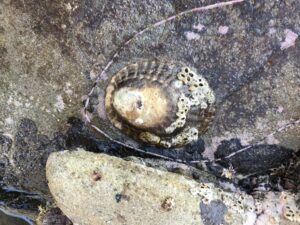Environmental Challenges for High School & Middle School Students

We need your help! Crystal Cove Conservancy partners with Crystal Cove State Park and local researchers to understand the best way to protect the park’s ecosystems, but we can’t do it alone. These challenges might include analyzing a large data set and sharing your findings back with us or developing and testing solutions to an engineering challenge.
The different environmental challenges align with different Next Generation Science Standards for middle school and high school.
We would like to know who is taking part in the program! Please fill out this participation form if you have used any of the challenges.
- Comparing Owl Limpet Populations: For the past two years, The Conservancy has partnered with OCMPAC and OCC students to monitor owl limpets at two sites in Crystal Cove State Park. Can you help analyze the data and create a visualization showing whether owl limpets at a highly-trafficked site are different from those in a more remote area? [High school level; NGSS SEP: Graphing and analyzing data, Constructing explanations.]
- California Gnatcatcher Mapping: Crystal Cove Conservancy staff and students have supplemented efforts by California State Park natural resource staff to monitor California Gnatcatcher populations in the park. Can you map gnatcatcher geospatial data from the past three years to look for observational trends? [Middle school to early high school level; NGSS SEP: Analyzing and interpreting data, Constructing explanations.]
- Monitoring Ocean Water Chemistry: Since 2012, Crystal Cove Conservancy has been partnering with Newport Whales and thousands of junior high and high school students to collect data on the pH, temperature, and salinity during our MPA Science Cruises. Can you analyze this water chemistry data and determine if there are any trends or patterns? [High school or middle school level; NGSS SEP: Graphing and analyzing data, Constructing explanations.]
- Monitoring Butterfly Populations: Crystal Cove Conservancy staff and volunteers have been conducting monthly butterfly surveys at a habitat restoration site in Moro Canyon. Can you analyze the data to determine if the butterfly population is improving over time? [High school or middle school level; NGSS SEP: Developing and using models, Graphing and analyzing data, Constructing explanations.]
- The Bowl Restoration Experiment: Crystal Cove State Park, The Conservancy, and UC Irvine are working together to restore an area in Crystal Cove called “The Bowl” that has changed over time from native coastal sage scrub to an invaded grassland dominated by non-native species. Can you analyze the data to determine which mix of native plants is the most effective and cost efficient for restoring coastal sage scrub? [High school level; NGSS SEP: Graphing and analyzing data, Constructing explanations.]
- Argentine Ant Experiment: Crystal Cove Conservancy and Crystal Cove State Park have partnered with scientists from UC Irvine’s and Pomona College to design an ecological experiment to investigate the effect that different types of mulch have on the abundance of non-native Argentine ants in the coastal sage scrub habitat. Can you analyze the data to determine if there is a difference in ant abundance between mulch treatments? [High school or middle school level; NGSS SEP: [Graphing and analyzing data, Constructing explanations.]
- North Beach Boardwalk: Crystal Cove Conservancy is in the process of restoring the remaining 17 unrestored cottages at the Historic District’s North Beach. Now we need your help to design and test a boardwalk that will provide access to the cottages and protect them from changing ocean and beach conditions for years to come. [High school level; NGSS SEP: Defining problems, Planning and carrying out investigations, Designing solutions]
